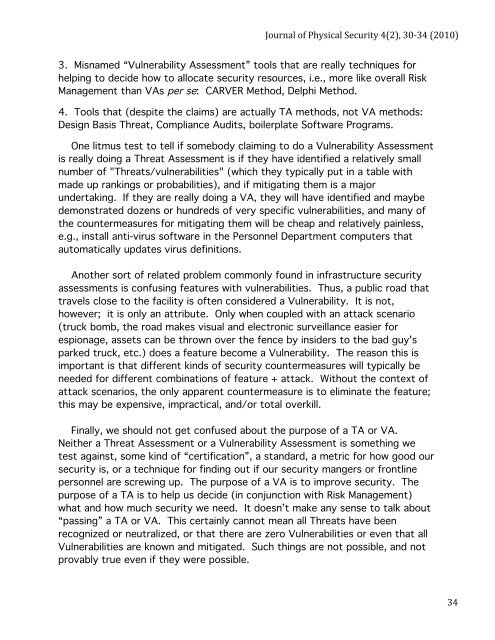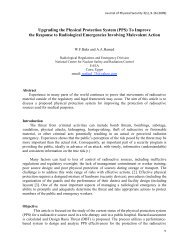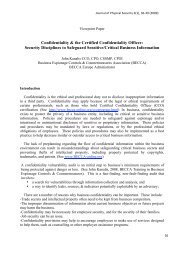PDF - The Journal of Physical Security - Argonne National Laboratory
PDF - The Journal of Physical Security - Argonne National Laboratory
PDF - The Journal of Physical Security - Argonne National Laboratory
Create successful ePaper yourself
Turn your PDF publications into a flip-book with our unique Google optimized e-Paper software.
<strong>Journal</strong> <strong>of</strong> <strong>Physical</strong> <strong>Security</strong> 4(2), 30‐34 (2010)3. Misnamed “Vulnerability Assessment” tools that are really techniques forhelping to decide how to allocate security resources, i.e., more like overall RiskManagement than VAs per se: CARVER Method, Delphi Method.4. Tools that (despite the claims) are actually TA methods, not VA methods:Design Basis Threat, Compliance Audits, boilerplate S<strong>of</strong>tware Programs.One litmus test to tell if somebody claiming to do a Vulnerability Assessmentis really doing a Threat Assessment is if they have identified a relatively smallnumber <strong>of</strong> "Threats/vulnerabilities" (which they typically put in a table withmade up rankings or probabilities), and if mitigating them is a majorundertaking. If they are really doing a VA, they will have identified and maybedemonstrated dozens or hundreds <strong>of</strong> very specific vulnerabilities, and many <strong>of</strong>the countermeasures for mitigating them will be cheap and relatively painless,e.g., install anti-virus s<strong>of</strong>tware in the Personnel Department computers thatautomatically updates virus definitions.Another sort <strong>of</strong> related problem commonly found in infrastructure securityassessments is confusing features with vulnerabilities. Thus, a public road thattravels close to the facility is <strong>of</strong>ten considered a Vulnerability. It is not,however; it is only an attribute. Only when coupled with an attack scenario(truck bomb, the road makes visual and electronic surveillance easier forespionage, assets can be thrown over the fence by insiders to the bad guy'sparked truck, etc.) does a feature become a Vulnerability. <strong>The</strong> reason this isimportant is that different kinds <strong>of</strong> security countermeasures will typically beneeded for different combinations <strong>of</strong> feature + attack. Without the context <strong>of</strong>attack scenarios, the only apparent countermeasure is to eliminate the feature;this may be expensive, impractical, and/or total overkill.Finally, we should not get confused about the purpose <strong>of</strong> a TA or VA.Neither a Threat Assessment or a Vulnerability Assessment is something wetest against, some kind <strong>of</strong> “certification”, a standard, a metric for how good oursecurity is, or a technique for finding out if our security mangers or frontlinepersonnel are screwing up. <strong>The</strong> purpose <strong>of</strong> a VA is to improve security. <strong>The</strong>purpose <strong>of</strong> a TA is to help us decide (in conjunction with Risk Management)what and how much security we need. It doesn’t make any sense to talk about“passing” a TA or VA. This certainly cannot mean all Threats have beenrecognized or neutralized, or that there are zero Vulnerabilities or even that allVulnerabilities are known and mitigated. Such things are not possible, and notprovably true even if they were possible.34





